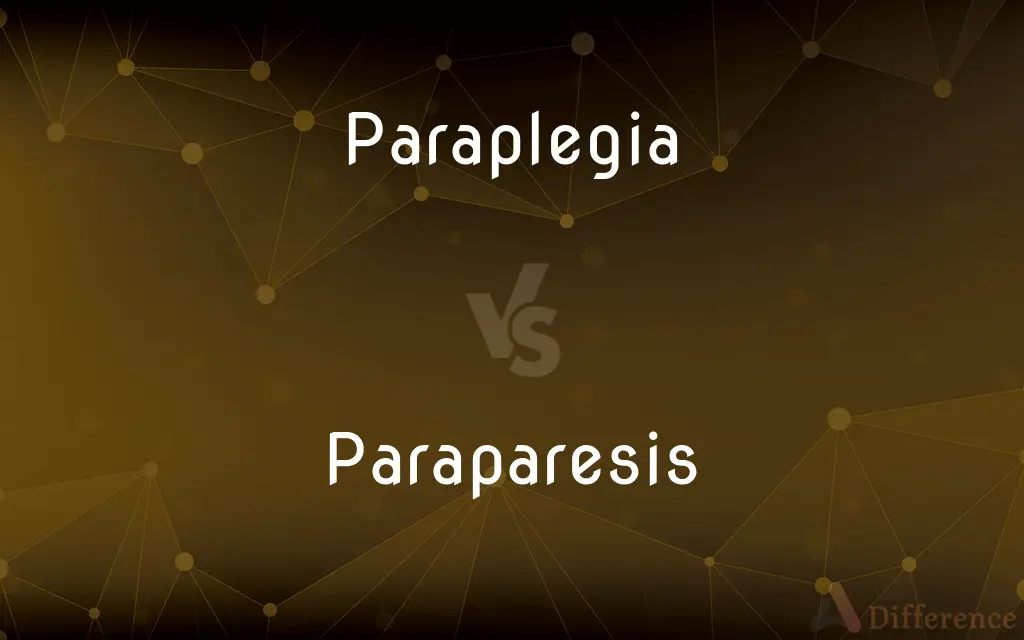Paraplegia vs. Paraparesis — What's the Difference?
By Urooj Arif & Fiza Rafique — Updated on April 14, 2024
Paraplegia involves complete paralysis of the lower limbs, often due to spinal injury; paraparesis, however, signifies partial paralysis affecting the same area.

Difference Between Paraplegia and Paraparesis
Table of Contents
ADVERTISEMENT
Key Differences
Paraplegia results in total loss of muscle function in the legs and lower body, typically caused by severe spinal cord damage. Paraparesis, on the other hand, is characterized by a partial loss of voluntary movement, which may vary in severity.
People with paraplegia cannot move their legs at all, which usually necessitates the use of wheelchairs for mobility. Whereas individuals with paraparesis may still have some degree of leg movement and might use mobility aids like canes or braces.
The causes of paraplegia include traumatic injuries, severe illness, or congenital conditions that severely affect the spinal cord. In contrast, paraparesis can result from less severe spinal injuries, mild strokes, or progressive diseases like multiple sclerosis.
Rehabilitation for paraplegia focuses extensively on adapting to complete loss of leg function and includes strategies for self-care and wheelchair use. Conversely, rehabilitation for paraparesis often involves physical therapy aimed at recovering as much leg function as possible.
Complications of paraplegia can include issues like pressure sores and urinary tract infections due to immobility. Whereas paraparesis may lead to complications like muscle spasms and partial immobility, but with less severity compared to paraplegia.
ADVERTISEMENT
Comparison Chart
Definition
Complete paralysis of the lower body
Partial paralysis of the lower body
Mobility
No leg movement; wheelchair-bound
Limited leg movement; may use canes or braces
Typical Causes
Severe spinal injury, congenital issues
Milder spinal injuries, diseases like MS
Severity of Condition
Severe, with no voluntary control of legs
Variable, ranging from mild to severe
Rehabilitation Focus
Adaptation to loss of mobility, wheelchair use
Maximizing remaining leg function, therapy
Compare with Definitions
Paraplegia
Requires comprehensive medical and supportive care.
Managing paraplegia involves both physical therapy and psychological support.
Paraparesis
Can result from less severe spinal injuries or neurological diseases.
Multiple sclerosis can lead to paraparesis over time.
Paraplegia
Often associated with spinal cord injuries at the thoracic level.
Paraplegia due to a T6 spinal injury is not uncommon in severe falls.
Paraparesis
Partial paralysis affecting the legs to varying degrees.
She has been living with paraparesis for several years now.
Paraplegia
Total paralysis of the lower half of the body due to spinal damage.
After the accident, he was diagnosed with paraplegia.
Paraparesis
Treatment focuses on enhancing muscle function.
Regular therapy is crucial for improving symptoms of paraparesis.
Paraplegia
Can lead to secondary health complications.
Long-term paraplegia increases the risk for pressure sores.
Paraparesis
Degree of mobility loss can vary significantly.
His paraparesis allows him to walk short distances with braces.
Paraplegia
Complete loss of sensation and movement in the legs.
Paraplegia has made him reliant on a wheelchair for mobility.
Paraparesis
Less severe than paraplegia but still impacts daily life.
Paraparesis has altered his lifestyle but he remains partially independent.
Paraplegia
Paraplegia is an impairment in motor or sensory function of the lower extremities. The word comes from Ionic Greek (παραπληγίη) "half-stricken".
Paraparesis
Partial paralysis of the lower limbs.
Paraplegia
Paralysis of the legs and lower body, typically caused by spinal injury or disease.
Paraparesis
Weakness of both legs, resulting from disease of the nervous system.
Paraplegia
Complete paralysis of the lower half of the body including both legs, usually caused by damage to the spinal cord.
Paraparesis
A slight paralysis or weakness of both legs
Paraplegia
(pathology) A condition where the lower half of a patient's body is paralyzed and cannot move.
Paraplegia
Palsy of the lower half of the body on both sides, caused usually by disease of the spinal cord.
Paraplegia
Paralysis of the lower half of the body (most often as a result of trauma)
Common Curiosities
What is paraplegia?
Paraplegia is the complete paralysis of the lower limbs and trunk, typically below the waist.
What is paraparesis?
Paraparesis refers to partial paralysis of the lower limbs, with varying degrees of movement and sensation remaining.
What causes paraplegia?
It is commonly caused by significant trauma to the spinal cord or by congenital conditions affecting the spinal areas.
What causes paraparesis?
Causes include mild to moderate spinal injuries, neurological disorders, or progressive diseases like multiple sclerosis.
Can paraparesis progress to paraplegia?
In some diseases like multiple sclerosis, paraparesis can progress, increasing the severity of symptoms, potentially leading to paraplegia.
Can children be born with paraplegia?
Yes, congenital defects or injuries at birth can cause paraplegia.
How does paraparesis differ from other forms of paralysis?
Paraparesis is specifically partial paralysis of the legs, unlike quadriplegia, which affects all four limbs.
How is paraplegia treated?
Treatment focuses on managing symptoms, preventing complications, and improving quality of life through rehabilitation and adaptive devices.
How do people with paraplegia manage mobility?
Typically, they use wheelchairs and may modify their home and workplace environments to accommodate their needs.
How does paraplegia affect emotional health?
The significant lifestyle changes and mobility limitations can impact emotional health, requiring support and counseling.
Are there specific therapies for paraparesis?
Yes, physical therapy is crucial and focuses on strengthening muscles and maximizing remaining mobility.
Is there a cure for paraplegia?
There is currently no cure, but ongoing research into spinal injuries and stem cell treatment offers hope.
How can paraparesis affect daily life?
It can vary greatly; some people may need minimal support, while others might require mobility aids.
Can exercise help with paraparesis?
Yes, supervised exercise is often recommended to maintain muscle tone and improve mobility.
What complications can arise from paraplegia?
Complications can include pressure sores, urinary infections, and depression.
Share Your Discovery

Previous Comparison
Underground vs. Basement
Next Comparison
Etching vs. DrawingAuthor Spotlight
Written by
Urooj ArifUrooj is a skilled content writer at Ask Difference, known for her exceptional ability to simplify complex topics into engaging and informative content. With a passion for research and a flair for clear, concise writing, she consistently delivers articles that resonate with our diverse audience.
Co-written by
Fiza RafiqueFiza Rafique is a skilled content writer at AskDifference.com, where she meticulously refines and enhances written pieces. Drawing from her vast editorial expertise, Fiza ensures clarity, accuracy, and precision in every article. Passionate about language, she continually seeks to elevate the quality of content for readers worldwide.














































